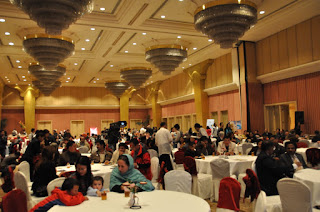Let's Walk for Clean Blue Sky in Kathmandu
Beyond the complexity of the pedestrian environment in Kathmandu, there is also the issue on air pollution. Particulate matters in forms of dust and vehicle emissions are high. You just need to stand at the center of Basantapur and inhale a deep breath to prove that this is true. In fact, during my first week here, I already developed dust allergy, a condition that I never had for more than 20 years. This is quite alarming especially for people who have to stay and live in this country for years.
 |
Photos by Chin Cabrido
|
In most developing countries, a large number of citizens walk as their daily social, recreational and livelihood activities. Every trip begins and ends with a walking trip. Nearly all trips made by people entail some walking either directly to a destination or to another mode of transport.
In Kathmandu, a large section of population prefers to walk. This was very evident when I first visited the Kathmandu Durbar Square, the week I first arrived in Nepal. With the intricate designs of its temples, this landmark has consistently attracted tourists from all parts of the world. In all my walks, I was constantly looking for a Filipino amongst the crowd, hoping that a familiar face would make me feel at home.
Walking in Kathmandu is a skill on its own. A narrow road is used for multiple purposes – vendors encroaching the footpaths, motorcycles and bicycles using the same street at the same time and rickshaws picking up tourists at the middle of the road. There are no clear signs to guide you where and when to cross safely to the other side. Everyday seems like a battle on who is the rightful owner of the road. I learned that in order to survive, I always have to set my guard high as a way to protect myself. Otherwise, I can be part of the 40 percent of pedestrian fatalities and injuries derived from unsafe pedestrian environment in Kathmandu (KVMP, 2001).
 |
| Photos by Chin Cabrido |
Beyond the complexity of the pedestrian environment in Kathmandu, there is also the issue on air pollution. Particulate matters in forms of dust and vehicle emissions are high. You just need to stand at the center of Basantapur and inhale a deep breath to prove that this is true. In fact, during my first week here, I already developed dust allergy, a condition that I never had for more than 20 years. This is quite alarming especially for people who have to stay and live in this country for years.
As a first step towards helping and encouraging cities such as Kathmandu to improve their pedestrian facilities, the Asian Development Bank in coordination with the Clean Air Initiatives for Asian Cities (CAI-Asia) is developing a ‘Walkability Index’. The index project is quite simple. Asian cities are ranked based on field surveys, pedestrian interviews and government surveys that will examine the safety and security, convenience and policy support towards efficient and safe pedestrian facilities. A single rank index is useful in encouraging the low-ranking cities to take actions and improve on its overall walking conditions. Aside from this, the gathered data will generate a countermeasure guidebook that will show city leaders what immediate and long term steps maybe taken to improve their index ranking. The documented data will be very useful in recommending further analyses such as spatial mapping of high risk areas or case studies. The end goal of the project is to promote walking as a sustainable urban transport.
This Walkability Index project will be implemented in Kathmandu next year by the Clean Energy Nepal (CEN). It has been a month now since I arrived in Nepal and I feel that I have learned a lot about the city’s walking conditions based from what I see and I encountered. This has given me more conviction that I can help make this place better for everyone. It may not be the ultimate solution, but i always believed that together, we can create small ripples to produce the waves. As a way forward, my CEN family together with the volunteers that we work with will continuously lobby with the government officials for an improved planning and investment in pedestrian infrastructure. So joint efforts needs to create awareness amongst the general public to make Kathmandu’s pedestrian facilities safer and accessible to everyone.
This story was released in Nepalnews in 2009
http://www.nepalnews.com/home/index.php/guest-column/2670-lets-walk-for-clean-blue-sky-in-kathmandu.html



Comments
Post a Comment